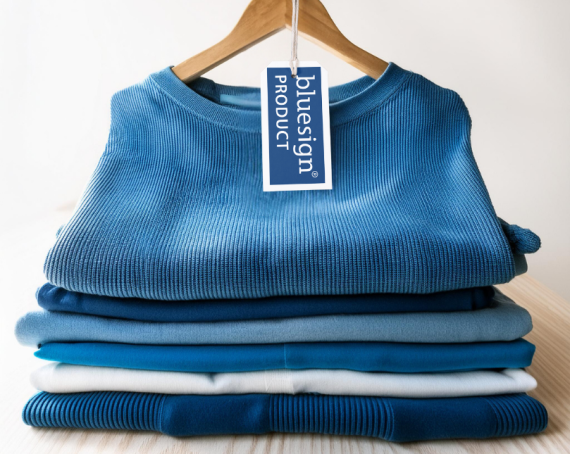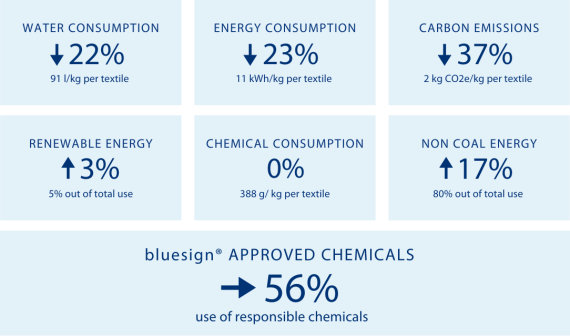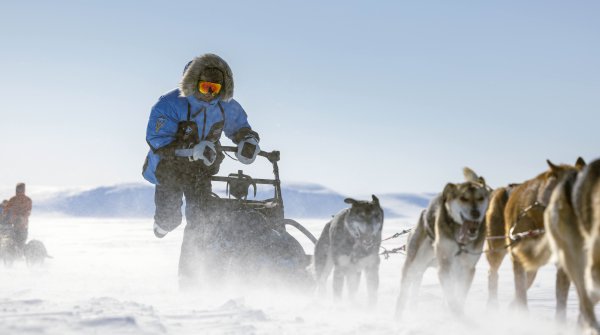Since its inception in 2000, bluesign's mission has been to reduce the environmental impact of the textile industry. Starting with the chemical industry, the idea from the beginning was to eliminate toxic chemicals from textile production from the outset, so that they do not become a problem either in the manufacturing process or in the finished product. There are now over 800 bluesign partners worldwide along the entire supply chain, from chemical manufacturers to textile or accessory manufacturers to brands, and around 26,000 chemical products and 80,000 materials certified according to the bluesign standard. In view of the upcoming legislative changes in the EU and beyond, this preparatory work is now proving to be a great advantage. Kutay Saritosun, Director of Brand Services and Partnerships at bluesign technologies ag, explains what new regulations the industry can expect and how bluesign is helping companies to comply with them.

Kutay Saritosun: There is a lot going on in terms of legislation, especially in the EU, but not only there. Under the European Union Green Deal initiative, there are several directives and regulations which will affect the entire apparel and textile industry, regardless of the segment, whether it's outdoor or denim, etc.
So brands are setting targets to reduce CO2 emissions. But these environmental impact reduction targets are not just related to carbon, which currently seems to be stealing the show from all the other environmental eKPIs. There are also targets for reducing water consumption, eliminating toxic chemicals in the supply chain, and so on. Reducing these impacts has been a hot topic over the past few years, and is also a very important part of upcoming legislation.
For example, there is the Corporate Sustainability Due Diligence Directive (CSDDD). This states that as a brand, you must know your supply chain partners and understand what social and environmental impacts they have in the supply chain. You must take measures to reduce these impacts and then eliminate them altogether in a next step. This directive is already in force. It applies first to large companies and will then be extended to medium-sized companies.
Once you know your supply chain partners and their impacts, an action plan is decided to reduce the impacts. The legislator wants these measures to be reported on annually. This is stated in the CSRD reporting guideline. So, not only is it important to understand the impacts and propose measures to reduce them, but you also need data from the supply chain to report on current developments.
Several things come into play under the ESPR. For example, there is a chapter entitled ‘Safe and sustainable by design’. Anyone designing chemical products or textile materials must not use toxic chemicals or substances. There is also the Waste Framework Directive, which stipulates that all waste must remain within Europe. Waste must not be shipped. This will also promote the circular economy. And there is the Green Claims Directive. Anyone who wants to make an environmental claim about an item of clothing must have that claim verified by a third party to prevent greenwashing. So, a lot is happening on the legislative side.
The digital product passport is another innovation that is to be introduced in the next two to three years. There are various approaches. At the moment, it looks as if there will be a mandatory QR code on every item of clothing. This is an indication that it is the digital twin of that item of clothing. This QR code will contain various layers of information, for example the certifications of the garment, the recycled content, which will also be mandatory in the future, the recyclability, it will contain all the information about the supply chain to promote transparency for consumers and for the industry. Some of these layers of information will be legally required, others will serve to promote transparency for consumers, and still others will help to prevent greenwashing. In a later version of the Digital Product Passport, the impact of products could also be recorded and a sustainability assessment in the form of a rating could be carried out. Nobody knows yet what this will look like, but companies will also need to know the impact of their products and prepare to communicate this impact in the Digital Product Passport.
We were founded in 2000, and the philosophy of bluesign has always been to reduce environmental impact. So, we have been dealing with this for a very long time! We work with the entire textile value chain, starting with the chemical manufacturers – because that's where the chemistry comes from – and moving on to textile manufacturers and brands. One of the founding principles of bluesign is still how we can eliminate toxic chemicals from textile production right from the start, so that the residual chemicals that do end up in the environment are harmless. The workers are also safe because they are not exposed to toxic chemical products, and that means that the consumers are safe too. This is also very important for the recycling of textiles. The idea behind bluesign is and always has been: how can we help material manufacturers to use clean chemistry with clean processes that meet our very strict environmental and worker safety criteria, and how can we help them improve resource efficiency? We now have over 800 system partners.
It's very important to understand that. bluesign is not a certifier, even though we have certifications: bluesign® Approved certification for chemical products and materials, and bluesign® Product for consumer products.
What sets bluesign apart is that since its inception, bluesign has focused on impact reduction and elimination of toxic substances from the textile value chain. When we work with textile manufacturers, we first conduct an on-site assessment of the production facility. We don't work through a checklist here that is about passing or failing. We assess where the company stands in terms of best practice environmental management. This includes air and water emissions, wastewater management, waste management, soil pollution, and others. All things that fall under the term environment, we assess on site. The second point is occupational health and safety. We assess the practices regarding worker health and safety at the facility. The third area we evaluate is resource efficiency. This means how much water, energy and chemicals are consumed in the plant and how high the CO2 emissions are. And this assessment leads to a gap analysis. After that, we can say where improvements need to be implemented according to the bluesign criteria. We create an action plan, and being a bluesign® SYSTEM PARTNER means implementing that action plan, bluesign partnering with you at every step of the implementation for improvement.
So bluesign certification of materials can only happen once the manufacturer implements bluesign, ensuring these materials are produced with reduced impact to the people and the planet.
Exactly. We have been working on reducing the impact for a long time, but now, with the new legislation, our work is becoming even more important. This is because the CSDDD states that companies must know their supply chain partners and their environmental and social impact, and as a result, propose measures to reduce that impact. This is exactly what we have been doing in the supply chain for the last 24 years.
If you are a brand that works with bluesign in its supply chain and the supply chain partners are bluesign system partner manufacturers, it means that we have already done the work for you as a brand partner. We are already working with these manufacturers to reduce the impact. So bluesign plays a very important role in understanding the impact in the supply chain for both brands and manufacturers, not only to understand the impact, but also to implement a system to reduce the impact.
Yes and then there is the fact that according to the CSRD guideline on sustainability reporting by companies, the current situation and progress must be reported. One of the things we provide to both manufacturers and brands is an annual impact report. All system partners receive an annual impact report that includes all eKPIs, i.e. water consumption, CO2 emissions, chemical consumption, energy consumption etc. The significance of this report lies in the fact that all the figures in it are verified by bluesign, because we go to the manufacturers on site. The manufacturers or brands can therefore simply use the verified-data from the bluesign annual impact report to use in their sustainability reporting. So, our work not only serves to reduce the impact on the supply chain, but also to verify and report on the impact in the supply chain. This plays a very important role today in terms of CSDDD and CSRD.

bluesign connects the textile value chain from chemical suppliers, to textile manufacturers to brands. Being a bluesign system partner brand gives you access to verified data from your supply chain which you can include in your Digital Product Passport. We will also be able to provide product-level impact data for our partners to use in their DPPs. We are currently in the process of further digitizing our tools to be able to support our partner brands with their DPP roll-out.
According to ESPR, no toxic substances should be used in the design of chemical products or materials. That is also our bluesign principle. There are currently 26,000 bluesign-approved chemical products available to the industry, which are publicly accessible. If you go to bluesignfinder.com, you can access these chemicals in our database for any purpose, e.g. for dyeing, finishing, coating, etc. Part of the bluesign implementation at manufacturing facilities is chemical change management. We evaluate the chemical products used at that facility and help them move to bluesign® APPROVED chemical products. Certification of materials can only happen if the manufacturer is using bluesign certified chemistry in the production of those materials.
This means that we have evaluated the formula of this chemical product. If it bears the bluesign seal, it means that it is a safe chemical product and does not contain any toxic substances. So if you are a system partner chemical manufacturer and have bluesign approved chemical products, then you automatically meet EU’s ‘Safe and Sustainable by Design’ framework. On the other hand, A ‘bluesign® APPROVED Fabric’ means that this manufacturer is a system partner that has implemented the bluesign® System and the way they manufacture textile materials and accessories meets our very strict environmental and worker safety criteria.
And if a fabric is bluesign certified, it means that all chemicals used in the production of that fabric also are bluesign certified. This allows the textile manufacturers to meet the ESPR, because ‘Safe and Sustainable by Design’ means that you are not allowed to use any toxic substances in the production of your fabrics/materials. This also sets us apart from other solution providers.
We created the Impact Scorecard for this purpose. Here we show how our system partners have developed over the last five years. For example, 226 system partner manufacturers have reduced their water consumption by 22 per cent, carbon emissions by 37 per cent and energy consumption by 23 per cent between 2019 and 2023. At the same time, they have increased the share of clean energy by 17 per cent and are using 56 per cent more approved bluesign chemicals in the supply chain. These figures are impressive. We also present case studies. For example, our system partner Dongjin Textile Vina Co. in Vietnam was able to reduce its total carbon emissions by a spectacular 77 per cent and its heating energy by 17 per cent within three years. Each system partner can track their current status in our online platform ‘Cube’.
Knowing how important reducing environmental impact is, we have introduced a second level of service called Impact Services. With Impact Services, we focus only on resource efficiency and impact. If a manufacturer is not yet ready to implement the full bluesign system but wants to understand and reduce its impact, they can do so with our Impact Services. As part of this offering, we visit the facility on site, and carry out an impact-related assessment. For this, too, we provide a roadmap for how these impacts can be reduced, and we provide an annual impact report, which of course is created with bluesign-verified data.
So we differentiate between two options for reducing the impact: on the one hand, there is the system partnership, which represents the complete implementation of bluesign for transformation, and on the other hand, there are the Impact Services, which involve a specific on-site assessment that focuses exclusively on the impact.
The same applies to brands that may want to understand and improve a strategic supply chain partner through Impact Services, where the manufacturer may not be ready for full integration into the bluesign system.
We are currently gearing our systems up for the digital product passport roll-out so that we can seamlessly provide verified data into brand DPPs. On the other hand, we have a digital platform called the Cube which is only accessible by our system partners. The platform has different tools for different system partners such as bluesign® Finder that contains over 26,000 bluesign certified chemical products and bluesign® Guide that hosts almost 80,000 bluesign® APPROVED materials and will also include products certified as bluesign® Product. Brands can use this online platform as a sourcing tool to search by country, material type, etc. and get in touch with the relevant system partner manufacturers or chemical suppliers. In the future, we want to expand this database into a marketplace. But I can't reveal any more than that yet.

- Awards
- Mountain sports
- Bike
- Fitness
- Health
- ISPO Munich
- Running
- Brands
- Sustainability
- Olympia
- OutDoor
- Promotion
- Sports Business
- Textrends
- Triathlon
- Water sports
- Winter sports
- eSports
- SportsTech
- OutDoor by ISPO
- Heroes
- Transformation
- Sport Fashion
- Urban Culture
- Challenges of a CEO
- Trade fairs
- Sports
- Find the Balance
- Product reviews
- Newsletter Exclusive Area
- Magazine




